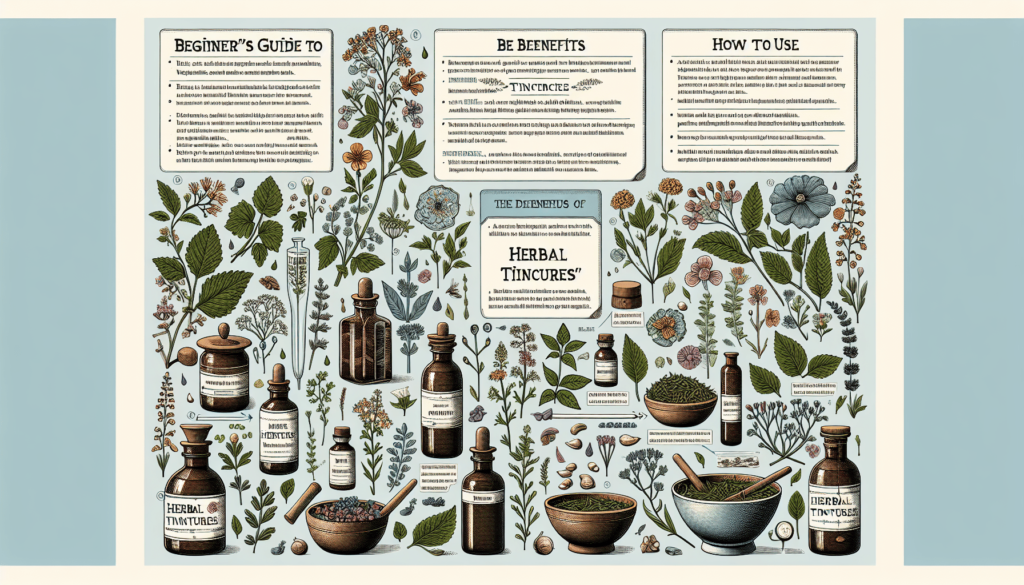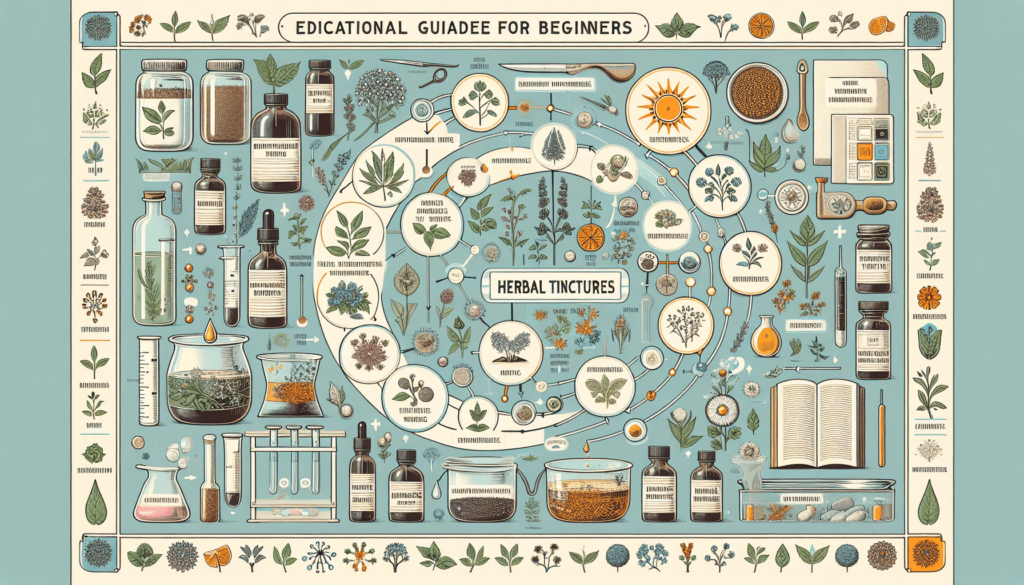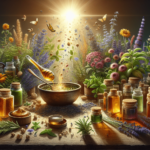So you’ve heard about herbal tinctures and their potential benefits, but you’re not quite sure how to go about using them? Look no further! In this beginner’s guide, we’ll walk you through the basics of using herbal tinctures, from understanding what they are to exploring different ways to incorporate them into your daily routine. Whether you’re seeking a natural remedy for common ailments or simply curious about the world of herbal medicine, this guide will equip you with the knowledge you need to start harnessing the power of herbal tinctures.
What are Herbal Tinctures?
Definition of Herbal Tinctures
Herbal tinctures are concentrated liquid extracts made from medicinal plants and herbs. They are often used to harness the therapeutic properties of these plants and make them more easily accessible for consumption. Tinctures are typically made by soaking plant materials in a solvent, such as alcohol or glycerin, which helps extract the active compounds from the herbs. This extraction process results in a potent liquid that can be taken orally for various health benefits.
Types of Herbs Used in Tinctures
A wide variety of herbs can be used to make tinctures, each with its unique properties and potential health benefits. Some commonly used herbs in tincture preparations include echinacea, chamomile, lavender, ginger, valerian root, and hawthorn. These herbs possess different medicinal properties, such as immune-boosting, calming, digestive aid, or heart health benefits. It is important to choose the right herb for the specific health concern or desired effect.
Benefits of Herbal Tinctures
Herbal tinctures offer several advantages over other forms of herbal preparations. Firstly, tinctures are highly concentrated, allowing for a more potent and bioavailable dose of the herb’s active compounds. This means that the body can absorb and utilize the beneficial constituents more efficiently. Additionally, tinctures have a long shelf life, especially when stored properly, making them convenient for long-term use.
Furthermore, herbal tinctures are versatile and can be easily incorporated into a daily wellness routine. They can be taken alone, added to water or juice, or even used topically for specific purposes. The ability to customize dosages and formulations based on individual needs is another notable benefit of herbal tinctures. Whether you are seeking relief from a specific health condition or simply trying to improve overall well-being, herbal tinctures offer a natural and holistic option for support.
Purchasing Herbal Tinctures
Choosing a Reputable Brand
When it comes to purchasing herbal tinctures, it is important to choose a reputable brand that follows good manufacturing practices and uses high-quality ingredients. Look for companies that prioritize sourcing organic or wildcrafted herbs and have a transparent manufacturing process. Reading customer reviews and seeking recommendations from trusted sources can also be helpful in determining the reputation and reliability of a brand.
Selecting the Right Herb
Before purchasing a tincture, it is essential to know which herb or combination of herbs will be most effective for your specific needs. Research the properties and uses of different herbs and consult with a healthcare professional or herbalist if you are unsure. Consider factors such as your health goals, any existing medical conditions, and potential interactions with medications before making a decision.
Checking for Quality and Purity
To ensure that you are getting a high-quality tincture, carefully check the label for information regarding the herb’s botanical name, extraction method used, and the solvent or menstruum used in the tincture preparation (such as alcohol or glycerin). Look for tinctures that are made with organic or ethically sourced herbs and have undergone rigorous testing for purity and potency. Avoid products that contain artificial additives or fillers.

Understanding Tincture Dosages
Recommended Dosage Guidelines
Dosage recommendations for herbal tinctures can vary depending on the herb, its concentration, and individual factors such as age, weight, and overall health. It is important to follow the recommended dosage guidelines provided by the manufacturer or consult with a healthcare professional who is knowledgeable in herbal medicine. It is generally advised to start with a low dosage and gradually increase if needed, while closely monitoring any potential effects.
Determining the Correct Dosage
Finding the correct dosage for a specific herb or condition may require some experimentation and observation. Factors such as the severity of the condition, individual sensitivity, and the intended purpose of the tincture can all influence the appropriate dosage. Begin with the lowest recommended dosage and assess how your body responds. Keep a record of any changes or improvements in your symptoms and consult with a healthcare professional if you have any concerns or questions.
Adjusting Dosages for Different Herbs
Different herbs may require different dosages to be effective. Some herbs are considered safe in higher doses, while others may be more potent and require smaller amounts. It is crucial to be aware of these variations and adjust the dosage accordingly. It is also important to note that certain herbs may have cumulative effects, meaning the benefits may increase over time with consistent usage.
Administering Herbal Tinctures
Using a Dropper or Liquid Measurement
Most herbal tinctures come with a dropper for precise measurement and administration. To use a tincture, simply squeeze the rubber bulb of the dropper and release it while submerged in the liquid. This will draw up the tincture into the dropper. Use the measurement lines on the dropper to ensure accurate dosing. If the tincture does not come with a dropper, a liquid measuring spoon or graduated cylinder can be used alternatively.
Mixing Tinctures with Water or Juice
If preferred, herbal tinctures can be mixed with water or juice to dilute the strong flavor and make it more palatable. Fill a glass with your desired amount of liquid, add the appropriate dosage of the tincture, and stir well. It is important to note that tinctures should not be mixed with hot liquids, as high temperatures may degrade the potency of the active constituents. It is best to use room temperature or cool beverages.
Timing and Frequency of Administration
The timing and frequency of administering herbal tinctures can vary depending on the herb’s properties and the desired effects. Some tinctures are more effective when taken on an empty stomach, while others may be better absorbed when taken with food. Read the product instructions and consult with a healthcare professional for guidance. It may also be beneficial to spread out the dosage throughout the day for more consistent effects.

Storing and Preserving Tinctures
Choosing Proper Storage Containers
Proper storage containers are essential for preserving the quality and effectiveness of herbal tinctures. Choose dark-colored glass bottles with tight-fitting lids to protect the tincture from light and air exposure. Amber or cobalt blue bottles are commonly used as they block harmful UV rays. Avoid using plastic containers, as they may interact with the tincture and compromise its potency. Ensure that the storage container is clean and sterilized before transferring the tincture.
Protecting Tinctures from Light and Heat
Light and heat can degrade the active compounds in herbal tinctures, reducing their efficacy. Store tinctures in a cool, dark place away from direct sunlight and heat sources such as stoves or radiators. Avoid storing tinctures in the bathroom, as the humidity can also compromise their quality. Refrigeration is not always necessary but can be used for tinctures that are particularly sensitive to heat or for extending shelf life.
Shelf Life and Expiration Dates
The shelf life of herbal tinctures can vary depending on several factors, including the herb, the extraction method, and the storage conditions. Tinctures made with alcohol as the solvent generally have a longer shelf life compared to those made with glycerin. Most alcohol-based tinctures can last for several years if stored properly, while glycerin-based tinctures may have a shorter shelf life. Check the expiration date provided by the manufacturer and discard tinctures past their prime.
Tips for Improving Tincture Absorption
Enhancing Absorption with Fats or Alcohol
Certain herbal compounds are better absorbed in the presence of fats or alcohol. Taking tinctures with a small amount of healthy fat, such as coconut oil or avocado, can enhance the absorption of fat-soluble constituents. Additionally, some tinctures may contain alcohol as a solvent, which can improve the extraction of certain medicinal compounds. However, if alcohol is a concern, there are alcohol-free tincture options available as well.
Taking Tinctures with Food or on an Empty Stomach
The absorption of herbal tinctures can be influenced by whether they are taken with or without food. Some tinctures are better absorbed on an empty stomach, allowing for quicker absorption of the active compounds. However, certain herbs may cause gastrointestinal discomfort when taken without food. In such cases, it is recommended to take the tincture with a small snack or a meal to minimize any potential side effects.
Avoiding Interactions with Medications
It is important to be aware of potential interactions between herbal tinctures and prescription medications. Some herbs may interfere with the absorption, metabolism, or effectiveness of certain medications. Consult with a healthcare professional or pharmacist to ensure that there are no contraindications or known interactions between the tincture and any medications you are currently taking. They can provide guidance on safe usage and potential risks.
Addressing Potential Side Effects and Allergies
Common Side Effects and Precautions
While herbal tinctures are generally safe to use, it is important to be aware of potential side effects and take appropriate precautions. Common side effects may include digestive discomfort, allergic reactions, or interactions with existing medications. It is important to start with a low dose and gradually increase if tolerated well. If any adverse effects occur or persist, discontinue use and consult with a healthcare professional.
Identifying Allergic Reactions
Allergic reactions to herbal tinctures are rare but can occur, especially in individuals with known allergies or sensitivities. Symptoms of an allergic reaction may include itching, hives, swelling, difficulty breathing, or dizziness. If you experience any signs of an allergic reaction after taking a tincture, discontinue use immediately and seek medical attention. It is also important to inform your healthcare provider of any known allergies before starting a new herbal supplement.
Consulting a Healthcare Professional
If you have any pre-existing health conditions, are pregnant or nursing, or are taking medications, it is important to consult with a healthcare professional before using herbal tinctures. They can provide personalized advice based on your individual needs and help determine if tinctures are appropriate for you. Additionally, a healthcare professional can monitor your progress and make any necessary adjustments to dosage or treatment plans.
Making Your Own Herbal Tinctures
Choosing the Right Herbs for Extraction
If you are interested in making your own herbal tinctures, it is essential to select the right herbs for extraction. Look for high-quality, organic herbs that are suitable for tincture preparations. Choose herbs that are known for their specific medicinal properties and align with your wellness goals. It is also important to ensure that the herbs are properly identified and authentic, as misidentifying plants can lead to safety concerns.
Preparing and Measuring Herbs and Alcohol
To make a herbal tincture at home, start by finely chopping or grinding the herb to increase its surface area and facilitate the extraction process. Next, measure the appropriate amount of herb based on the recommended ratio of herb to alcohol. Generally, a common ratio is 1 part herb to 5 parts alcohol by volume. Place the herb in a clean glass jar and pour the alcohol over it, ensuring that the herb is fully submerged.
Steeping and Straining the Mixture
Once the alcohol has been added, securely close the jar and shake it vigorously to ensure thorough mixing. Label the jar with the herb’s name, the date of preparation, and the expected extraction time. Let the mixture steep for several weeks, shaking it periodically to aid the extraction process. After the desired steeping period, strain the mixture using a fine mesh sieve or cheesecloth to remove the plant materials. Transfer the tincture to a clean glass bottle, label it, and store it as mentioned earlier.
Labeling and Documenting Tinctures
Properly Labeling Tincture Bottles
Properly labeling tincture bottles is crucial to avoid confusion and ensure safe and informed usage. Label the bottle with the herb’s name, the extraction date, the ratio of herb to solvent, and any additional information, such as special instructions or contraindications. It may also be helpful to include the expected duration of use, recommended dosage guidelines, and any relevant batch or lot numbers.
Recording Recipe Details and Dosages
To keep track of your tincture-making endeavors, it is beneficial to document the recipe details and dosages in a notebook or electronic file. Include information such as the herb used, the extraction ratio, the type and strength of alcohol or solvent used, and any specific process details. Also, record the dosage guidelines and any adjustments made along the way. This documentation can serve as a helpful reference for future use and experimentation.
Organizing and Storing Documentation
Organizing and storing tincture documentation is important for easy accessibility and reference. Keep all the recipe details, notes, and dosage information in a designated folder, notebook, or digital document. You can further organize the documentation by categorizing it based on the type of herb or the desired effects. Maintaining an organized record of your tinctures will make it easier to track their efficacy and create new formulations.
Seeking Professional Guidance
Consulting an Herbalist or Naturopath
For a more personalized approach to using herbal tinctures, consider consulting with a qualified herbalist or naturopath. These professionals have in-depth knowledge of herbs and their specific uses, and can provide tailored recommendations based on your individual needs and health concerns. They can guide you in selecting the most appropriate herbs, creating customized formulations, and adjusting dosages as needed.
Discussing Tincture Usage with a Healthcare Provider
If you are currently under the care of a healthcare provider, it is important to discuss your intentions to use herbal tinctures with them. They can provide guidance on potential interactions with any prescribed medications and ensure that the tinctures align with your overall treatment plan. Your healthcare provider can also monitor your progress and make any necessary adjustments to dosage or treatment protocols.
Navigating Contraindications and Pre-existing Conditions
Certain health conditions or medications may have contraindications or precautions when using herbal tinctures. It is vital to inform your herbalist, naturopath, or healthcare provider about any pre-existing conditions, allergies, medications, or ongoing treatments. They can assess any potential risks or interactions and guide you in making informed decisions about using herbal tinctures. Your health professional can help you navigate any complexities and ensure your safety and well-being.





